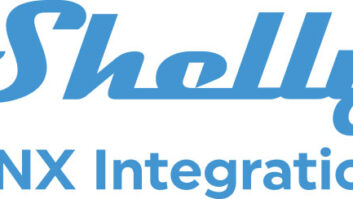Audio Video Bridging Promises Low-Latency, Synchronized AV Networking

A diagram of a typical consumer networking system using AVBcompliant switches.
While audio and video over IP is a routine process and offers some interesting delivery opportunities, most current solutions remain limited in their scope and can run into delivery snags. The consumer electronics industry still needs a plug-andplay networking technology that incorporates off-the-shelf routers and standard RJ-45 Cat-5/6 cabling so that users can stream real-time, on-demand digitized sound and pictures plus control data, within a multi-room residential environment.
As it happens, such a networking topology is beginning to migrate down from the professional AV channel. Called Audio Video Bridging (AVB, for short) this standard is being developed by some clever folks at the Institute of Electrical and Electronics Engineers (IEEE) to provide lowlatency, guaranteed bandwidth and, of critical importance, highly accurate synchronization between HD images and multichannel audio soundtracks. And because AVB embraces both system-control data and digital bitstreams (the format reserves up to 75 percent of its network capacity for audio and video streams, with any unreserved space available for data) there is no need for a separate connection to carry remote-control information. In addition, a suitably equipped ethernet bridge could distribute power, for example, to local low-wattage amplifiers. Ethernet AVB also offers sufficient bandwidth to distribute compressed and uncompressed 1080p HD video.
A Non-Proprietary Scheme
Previous solutions making the same promise as AVB have been only partially successful. Proprietary protocols, such as CobraNet, EtherSound, Dante, and others, forced hardware vendors and installers to tie themselves to royalty structures and long-term support issues. Also, compatibility between such competitive networking schemes can lead to long-term frustrations. What AVB offers is a non-proprietary scheme that, from the outset, was developed to ensure a level playing field for hardware and software vendors. And a recently formed organization, AVnu Alliance, includes members drawn from the pro-AV, consumer electronics, and automotive industries that are committed to supporting and advocating the IEEE-devised AVB scheme.
“Existing networking schemes do not incorporate timing data,” said Robert Boatright, director of research of Harman International’s corporate technology group. “With AVB, each data packet is time-stamped by each input port; the data follows digitized AV material through the network to its assigned delivery point,” where the timing data ensures low-latency and accurately synchronized audio-video playback.
“With 10 Gbit ethernet just around the corner, end users can develop reliable networks with data bandwidth necessary to handle on-demand multichannel audio, HD video, and control data,” Boatright predicted.
The Heavy Lifting is Done
AVB is designed to work over widely used IEEE 802 layer 2 networks that provide connectivity features for tightly controlled media stream synchronization, buffering, and bandwidth reservation. AVB enables higher-layer protocols and applications to provide consistent, reliable AV transfers even if there are various lower layer network links in the path between end-point devices. For instance, a data transfer will only be initiated if it is determined by the sending device, such a media server or residential AV gateway, that there is sufficient, sustainable bandwidth on the connection to ensure uninterrupted service.
Even though, for obvious reasons, an AVBcompliant network will require newer generation switches and bridges, many of the systems currently available have AVB capability built in, and will just need a firmware upgrade.
Harman, along with other leading manufacturers, has begun developing consumertargeted components for an AVB network. The Harman Performance AV (HPAV) group, under the direction of Blake Augsburger, worldwide president/CEO of the firm’s professional division, is looking to offer multi-zone AV processors and amplifiers. HPAV includes Mark Levinson, Revel, JBL Synthesis, and Lexicon consumer brands. IEEE 802.1 Ethernet AVB will be implemented within HPAV products during calendar 2011. (Harman also plans to develop AVB technology for its automotive OEM business.)
“Much of the heavy lifting has already been completed,” Augsburger noted. “Technology leaders from the semiconductor field, network computing, consumer electronics, and pro AV sectors have developed and ratified the standard, and AVnu Alliance is actively promoting that standard. It’s now being deployed and tested in the pro market and delivering real value: cost-per-node is very compelling, and easy to install. As the technology proves itself in the demanding pro market, I see it making its way into [other] markets.”
Incidentally, Harman’s professional division is reported to be looking to acquire a video company that could offer manufacturing expertise in several key segments, including control, servers, signal conditioners, and display.
“As a corporation, we work increasingly closer together,” Augsburger stressed. Because Harman shares R&D between its various divisions, “[we] can apply the best ideas from pro, automotive and CI into CE and vice versa; culturally, we’re committed to the improved value and customer experience that a unified One Harman can deliver,” he said.
Cost-Effective Video Routing
As Ronny Dewaele, director of Barco’s technology center points out, AVB will enable ethernet networks to support multiple video bit streams within the consumer environment. It also will ensure guaranteed bandwidth from server to video monitors located anywhere within a multi-room environment, with companion 5.1-channel sound.
“AVB provides a level of low-latency, bandwidth reservation and tight AV synchronization that other networking schemes do not come close to offering,” Dewaele said. “System congestion for both compressed and uncompressed HD signals is a major problem. You either need to provide large amounts of buffering within switches, or develop a way of ensuring that, once initiated, the data pathway from source to destination is guaranteed. This is exactly what AVB offers; it will make network switches cost effective for building videorouting systems within the home environment.”
Also in development are protocol extensions that will provide plug-and-play between AVBcompliant systems from different manufacturers, including automatic discovery, enunciation, and communications across networks.
“AVB-compliant components on a network will advertise who they are,” Boatright explained, “and enumerate what they are capable of delivering” in terms of digitized AV bitstreams. “Then, if the subsystems are deemed compatible [by the controlling system-command program], they will be able to communicate with one another.”
Mel Lambert ([email protected]) has been involved with the international production industry for many years and is a principal of Media&Marketing, in Los Angeles.
The AVnu Alliance Provides a Forum

John McMahon, Meyer Sound
AVnu Alliance is dedicated to the advancement of professional-quality AV transport using IEEE 802.1 Audio Video Bridging (AVB), and the related IEEE 1722 and IEEE 1733 standards over various networking link layers. The organization, founded a year ago, includes prominent members of the pro- AV community, notably, Harman International, Barco, Avid, and Meyer Sound, together with a number of familiar chip manufacturers, including Intel, Marvell, and Xilinx, and connectivity gurus Broadcom, Cisco, and design firm Lab X Technologies. Other members include Samsung, Bosch, Analog Devices, Applied Micro, Audinate, Biamp, Marvell, Peavey, and Shure.
The various in-progress IEEE standards cover specific details of how audio and video should be transported and synchronized over ethernet connections. AVB has expanded the original format to ensure reliable, robust, and lowlatency connections.
“Our industry is too small to support proprietary networking solutions,” said John McMahon, executive director of digital products at Meyer Sound, one of the Alliances’ promoting members. “By leveraging the ubiquity of mainstream ethernet, we have an open, non-proprietary standard that benefits both end-users and hardware manufacturers.”
In essence, the AVnu Alliance provides a forum that enables manufacturers to work together to further the adoption and acceptance of a single open networking standard, rather than continuing to support a variety of different proprietary protocols.
Visit www.avnu.org to learn more.
A Practical Demo of AVB Connectivity


Michael Johas Teener (right), technical director of Broadcom’s Enterprise Networking Group, and Benjamin Hur, application engineer, led a technology demonstration organized by Broadcom at CES 2010. The inset photo shows outputs from the D-to-A converter in the first and second Crown amplifiers demonstrating perfect synchronism within the playback devices.
At last January’s CES Convention in Las Vegas, chipmaker Broadcom set up a special demonstration of Audio/Video Bridging in a real-world application. Digitized audio was sent from a dbx digital processor through two prototype BSS/NetGear AVB-compliant ethernet switches to a pair of Crown power amplifiers. Harman Professional’s System Architect and HiQnet command protocol handled system configuration and control. Broadcom’s chipsets provided AVB interfacing and the generation of timing reference signals to provide low-latency, on-demand delivery of multichannel audio. AVB’s time stamping and guaranteed bandwidth from source to destination helped the two signals arrive in perfect synchronism despite dramatic differences in ethernet path lengths and switcher-port connections.







